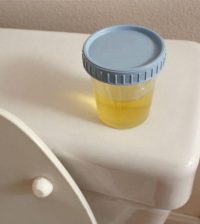- Big Health Care Disparities Persist Across the U.S., New Report Finds
- Teens Often Bullied Online About Their Weight: Study
- Work That Challenges Your Brain Helps You Stay Sharp With Age
- Urine Test Might Spot Head-and-Neck Cancers Early
- Many Seniors Are Overmedicated, But ChatGPT Might Prevent That
- Antipsychotics May Do Great Harm to People With Dementia: Report
- Two-Drug Combo Curbs Drinking for People Battling Severe Alcoholism
- Most Homeless Americans Are Battling Mental Illness
- FDA Recalls Heart Failure Devices Linked to Injuries and Deaths
- COVID Does Not Spur Asthma in Kids, Study Finds
Health Highlights: Aug. 12, 2020

Here are some of the latest health and medical news developments, compiled by the editors of HealthDay:
Scientists Find Coronavirus in Hospital Room Air
Respiratory droplets called aerosols floating in the air do carry coronavirus that can infect people, The New York Times reported Tuesday.
This finding may appease those who are skeptical this could occur.
“This is what people have been clamoring for,” Linsey Marr, an expert in airborne spread of viruses who was not involved in the work, told the Times. “It’s unambiguous evidence that there is infectious virus in aerosols.”
Researchers from the University of Florida have found live virus in aerosols collected at distances of seven to 16 feet from hospitalized COVID-19 patients. That’s more than the 6 feet recommended for social distancing.
The results of the study were available online last week, although they haven’t been peer-reviewed.
Yet they have already caused a stir. “If this isn’t a smoking gun, then I don’t know what is,” Marr tweeted.
Some experts, however, say it’s not clear that the amount of virus found was enough to cause an infection, according to the Times.
“It’s very hard to sample biological material from the air and have it be viable,” Shelly Miller, an environmental engineer at the University of Colorado Boulder who studies air quality and airborne diseases, told the Times.
“We have to be clever about sampling biological material so that it is more similar to how you might inhale it.”
In this new study, researchers made a sampler that uses water vapor to enlarge the aerosols so they can be collected from the air.
The device transfers the samples to a liquid containing salts, sugar and protein, which preserves the virus.
“I’m impressed,” Robyn Schofield, an atmospheric chemist at Melbourne University in Australia, who measures aerosols over the ocean, told the Times. “It’s a very clever measurement technique.”
The researchers took air samples from a room dedicated to COVID-19 patients at the University of Florida Health’s Shands Hospital.
Neither patient in the room had any procedures that generate aerosols, which the World Health Organization has said is the main source of airborne virus in hospitals.
Genetic analysis of the virus in the aerosols, however, showed that the virus was the same as that of an asymptomatic patient newly brought into the room.
Room air was changed six times per hour and was fitted with filters, ultraviolet light and other measures to kill the virus before the air was introduced into the room.
These precautions might explain why only 74 virus particles per liter of air were found, researcher John Lednicky, a virologist at the University of Florida, told the Times.
Rooms without good ventilation, such as schools, might have a lot more virus floating in the air, he said.
But some experts disagree.
“I’m just not sure that these numbers are high enough to cause an infection in somebody,” Angela Rasmussen, a virologist at Columbia University in New York, told the Times.
“The only conclusion I can take from this paper is you can culture viable virus out of the air,” she said. “But that’s not a small thing.”
The distance at which the team found virus is much more than the recommended distance for physical distancing, some experts said.
“We know that indoors, those distance rules don’t matter anymore,” Schofield said. The 6-foot minimum is “misleading, because people think they are protected indoors and they’re really not,” she said.
These findings should make people take precautions like improved ventilation, Seema Lakdawala, a respiratory virus expert at the University of Pittsburgh, told the Times.
“We all know that this virus can transmit by all these modes, but we’re only focusing on a small subset,” Lakdawala said.
One odd finding is that the researchers found just as much viral RNA as they did infectious virus when other methods found about 100 times more genetic matter.
“When you do nasal swabs or clinical samples, there is a lot more RNA than infectious virus,” Lakdawala said.
Lednicky said he would check his numbers again to be sure. But in any event, the message is clear, he said.
“We can grow the virus from air — I think that should be the important take-home lesson,” he told the Times.
—–
Coronavirus Back in New Zealand After 102 Days
Four cases of COVID-19 have turned up in Auckland, New Zealand, after 102 days of no new reported infections in that country, the Associated Press reported Tuesday.
The four cases have been confined to one household, but Prime Minister Jacinda Ardern has asked people in Auckland to stay home and bars and many other businesses will close for three days.
“These three days will give us time to assess the situation, gather information, make sure we have widespread contact tracing so we can find out more about how this case arose and make decisions about how to respond to it once we have further information,” Ardern said at a news conference late Tuesday.
“I know that this information will be very difficult to receive,” Ardern said. “We had all hoped not to find ourselves in this position again. But we had also prepared for it. And as a team, we have also been here before.”
Also, she is banning traveling into Auckland unless it’s traveling home.
In the rest of the nation mass gatherings will be limited to 100 attendees and people would need to socially distance themselves from each other until Friday.
On Monday, one person tested positive for the virus and six other people in the household were then tested, with three more positive results, Director-General of Health Ashley Bloomfield said.
“Importantly, the person has no history of overseas travel,” Bloomfield said, adding that the source of the infections isn’t known.
Before these cases the only known infections were 22 travelers who had returned from abroad and were being held in quarantine, the AP reported.
New Zealand had gotten rid of the virus by a strict lockdown in late March when only about 100 had the disease. That stopped its spread.
—–
Russia Approves COVID-19 Vaccine Before Trials Completed
Before completing clinical trials to ensure the vaccine is safe and effective, the Russian government has gone ahead and approved a vaccine against the new coronavirus, the New York Times reported Tuesday.
According to Russian President Vladimir Putin, the vaccine works “effectively enough.”
The premature approval of a vaccine confirms concerns from other nations that Russia is more interested in making political and propaganda hay in the race to acquire a working vaccine, the Times reported.
Putin’s announcement comes despite a lack of published data on any testing for the vaccine.
Last week the World Health Organization urged Russia not to bypass the usual methods of testing to ensure safety and effectiveness.
“It works effectively enough, forms a stable immunity and I repeat, it has gone through all necessary tests,” Putin told a Cabinet meeting on Tuesday. He also said one of his daughters been given the vaccine, the Times said.
The Russian vaccine was rushed through monkey and early human trials and was most likely successful. But it hasn’t been widely tested in large phase 3 trials — the only way of ensuring it’s safe and effective in broad populations.
Mikhail Murashko, Russia’s minister of health, has said mass vaccination will start in October, beginning with teachers and medical workers.
The Russia approval comes far ahead of when Western countries are expected to have a working vaccine, which isn’t expected before the end of the year.
The United States, Canada and Britain have accused Russian hackers of trying to steal vaccine research, spurring doubt that Russia has achieved any medical breakthrough on its own.
The Russians have said say their vaccine is based on an Ebola vaccine they developed years ago, the Times reported.
The Russian vaccine uses two strains of adenovirus — viruses that typically cause mild colds in humans. Similar vaccines are being tested in other countries. It’s the approach being used by Oxford University and drug maker AstraZeneca.
——
FDA Head Says Any Approved COVID-19 Vaccine Will Be Safe
Dr. Stephen Hahn, the head of the U.S. Food and Drug Administration, said Monday that the agency will not compromise safety when approving COVID-19 vaccines, CNN reported.
That assurance was given during a video briefing with the American Medical Association.
Because of how fast the FDA is working, some have questioned if the agency will weaken its usual rigor when it reviews data from clinical trials.
“Let me assure you that we will not cut corners,” Hahn said. “All of our decisions will continue to be based on good science and the same careful deliberative processes we have always used when reviewing medical products.”
Many Americans are wary of a vaccine. Hahn said he has seen surveys that show that many people will be reluctant to get vaccinated.
In May, a CNN poll found one-third of Americans wouldn’t get a COVID-19 vaccine even if it is widely available and inexpensive.
Hahn urged doctors to get their patients to take the vaccine when it’s approved.
“We hope that you will urge your patients to take an approved vaccine so that we can seek to establish widespread immunity,” he said.
More than 200 trials are underway, Hahn said, but no one knows when the results of those trials will be ready.
“I can promise you that when the data are available, FDA will review them, using its established rigorous and deliberative scientific process. We all understand that only by engaging in an open review process and relying on good science and sound data can the public, and you as providers, have confidence in the integrity of our decisions,” he said.
Despite claims by President Donald Trump that a vaccine will be ready in November, experts say that’s not possible.
“I don’t see how that would be possible,” Dr. Paul Offit, a vaccinologist at Children’s Hospital of Philadelphia, told CNN.
Before a trial can start, Moderna, a company that’s ahead of most in developing a vaccine, needs to finish enrolling patients in late-stage trials. That might happen by the end of September. Then the volunteers have to have their first shots, wait 28 days, and then give a second shot. After that, researchers have to wait two weeks to see if the vaccine is effective.
Dr. Peter Hotez, a vaccinologist at Baylor College of Medicine in Houston, told CNN “there’s just no way” a vaccine will be available by Nov. 3. It’s more likely a vaccine will be available in 2021, he added.
Copyright © 2024 HealthDay. All rights reserved.










